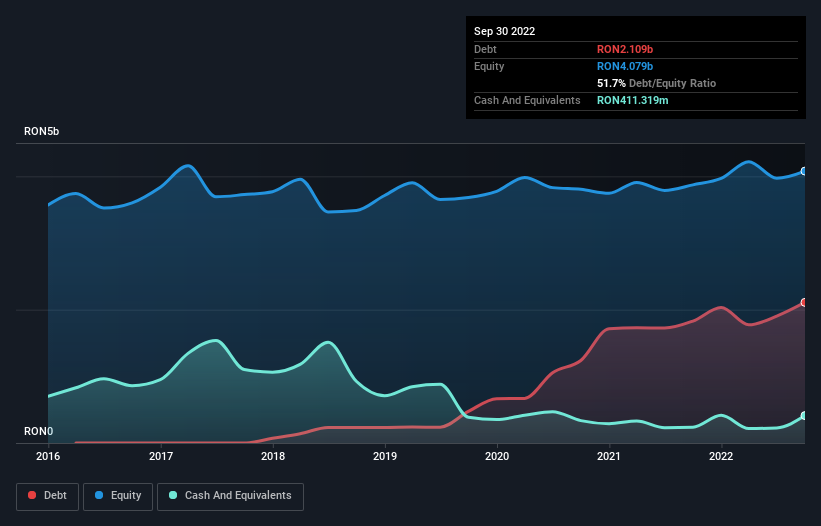
Some say volatility, rather than debt, is the best way to think about risk as an investor, but Warren Buffett famously said that 'Volatility is far from synonymous with risk.' When we think about how risky a company is, we always like to look at its use of debt, since debt overload can lead to ruin. We can see that S.N.T.G.N. Transgaz S.A. (BVB:TGN) does use debt in its business. But is this debt a concern to shareholders?
When Is Debt A Problem?
Generally speaking, debt only becomes a real problem when a company can't easily pay it off, either by raising capital or with its own cash flow. Ultimately, if the company can't fulfill its legal obligations to repay debt, shareholders could walk away with nothing. While that is not too common, we often do see indebted companies permanently diluting shareholders because lenders force them to raise capital at a distressed price. Of course, plenty of companies use debt to fund growth, without any negative consequences. When we think about a company's use of debt, we first look at cash and debt together.
View our latest analysis for S.N.T.G.N. Transgaz
What Is S.N.T.G.N. Transgaz's Debt?
As you can see below, at the end of September 2022, S.N.T.G.N. Transgaz had RON2.11b of debt, up from RON1.83b a year ago. Click the image for more detail. However, it does have RON411.3m in cash offsetting this, leading to net debt of about RON1.70b.

How Strong Is S.N.T.G.N. Transgaz's Balance Sheet?
We can see from the most recent balance sheet that S.N.T.G.N. Transgaz had liabilities of RON905.2m falling due within a year, and liabilities of RON3.07b due beyond that. Offsetting these obligations, it had cash of RON411.3m as well as receivables valued at RON254.4m due within 12 months. So its liabilities total RON3.31b more than the combination of its cash and short-term receivables.
This is a mountain of leverage relative to its market capitalization of RON3.37b. Should its lenders demand that it shore up the balance sheet, shareholders would likely face severe dilution.
We use two main ratios to inform us about debt levels relative to earnings. The first is net debt divided by earnings before interest, tax, depreciation, and amortization (EBITDA), while the second is how many times its earnings before interest and tax (EBIT) covers its interest expense (or its interest cover, for short). The advantage of this approach is that we take into account both the absolute quantum of debt (with net debt to EBITDA) and the actual interest expenses associated with that debt (with its interest cover ratio).
S.N.T.G.N. Transgaz's net debt is 3.1 times its EBITDA, which is a significant but still reasonable amount of leverage. However, its interest coverage of 1k is very high, suggesting that the interest expense on the debt is currently quite low. Pleasingly, S.N.T.G.N. Transgaz is growing its EBIT faster than former Australian PM Bob Hawke downs a yard glass, boasting a 5,241% gain in the last twelve months. When analysing debt levels, the balance sheet is the obvious place to start. But it is future earnings, more than anything, that will determine S.N.T.G.N. Transgaz's ability to maintain a healthy balance sheet going forward. So if you want to see what the professionals think, you might find this free report on analyst profit forecasts to be interesting.
Finally, while the tax-man may adore accounting profits, lenders only accept cold hard cash. So the logical step is to look at the proportion of that EBIT that is matched by actual free cash flow. During the last three years, S.N.T.G.N. Transgaz burned a lot of cash. While that may be a result of expenditure for growth, it does make the debt far more risky.
Our View
We feel some trepidation about S.N.T.G.N. Transgaz's difficulty conversion of EBIT to free cash flow, but we've got positives to focus on, too. To wit both its interest cover and EBIT growth rate were encouraging signs. Taking the abovementioned factors together we do think S.N.T.G.N. Transgaz's debt poses some risks to the business. So while that leverage does boost returns on equity, we wouldn't really want to see it increase from here. When analysing debt levels, the balance sheet is the obvious place to start. But ultimately, every company can contain risks that exist outside of the balance sheet. Be aware that S.N.T.G.N. Transgaz is showing 2 warning signs in our investment analysis , you should know about...
If you're interested in investing in businesses that can grow profits without the burden of debt, then check out this free list of growing businesses that have net cash on the balance sheet.
New: Manage All Your Stock Portfolios in One Place
We've created the ultimate portfolio companion for stock investors, and it's free.
• Connect an unlimited number of Portfolios and see your total in one currency
• Be alerted to new Warning Signs or Risks via email or mobile
• Track the Fair Value of your stocks
Have feedback on this article? Concerned about the content? Get in touch with us directly. Alternatively, email editorial-team (at) simplywallst.com.
This article by Simply Wall St is general in nature. We provide commentary based on historical data and analyst forecasts only using an unbiased methodology and our articles are not intended to be financial advice. It does not constitute a recommendation to buy or sell any stock, and does not take account of your objectives, or your financial situation. We aim to bring you long-term focused analysis driven by fundamental data. Note that our analysis may not factor in the latest price-sensitive company announcements or qualitative material. Simply Wall St has no position in any stocks mentioned.
About BVB:TGN
S.N.T.G.N. Transgaz
Engages in the transmission of natural gas in Romania and internationally.
Proven track record with imperfect balance sheet.

